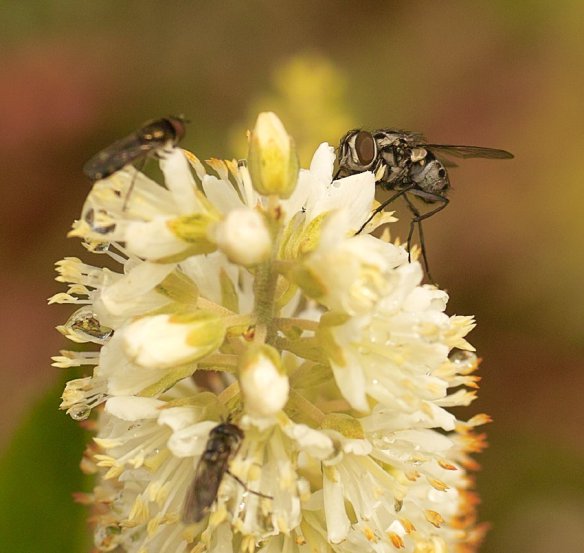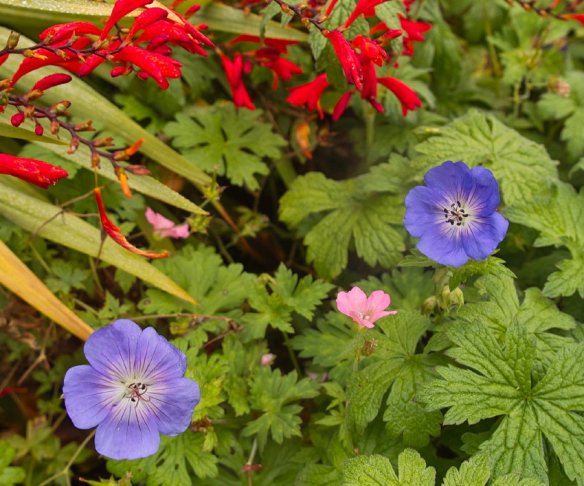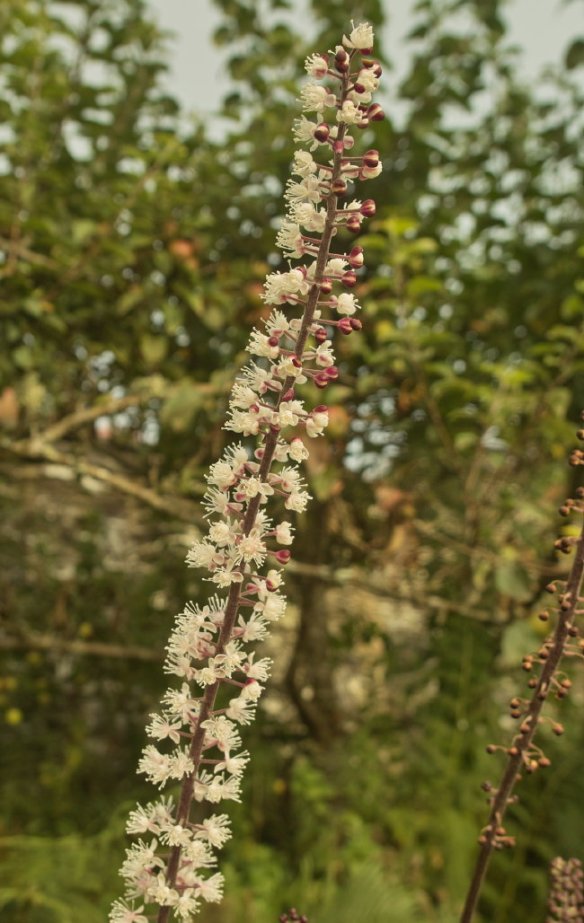Below are our 12 favourite plants from the garden in late September 2016. Many will already have been in flower for a short period, and, of course, overlap with the previous fortnight’s favourites. Its an important time for choosing flowers to accompany the first hints of autumnal leaf colour which are often appearing by the end of the month.
1:Hydrangea “Blaumeise”. For a long time we thought this Hydrangea was called (Blue) Zorro, having lost the original name, but it doesn’t have the black stems typical of that cultivar, so we think that this is the correct name. If so, it was also previously known as “Blue Tit”.  It’s another of our favourite Hydrangeas, which by late September will already have been flowering for over 2 months.
It’s another of our favourite Hydrangeas, which by late September will already have been flowering for over 2 months.  The large outer part of the flower heads begin deep blue, in our acid soil, but as they age take on purplish hues. The smaller inner flowers are a pale blue, and occasionally attract honey bees for pale blue pollen.
The large outer part of the flower heads begin deep blue, in our acid soil, but as they age take on purplish hues. The smaller inner flowers are a pale blue, and occasionally attract honey bees for pale blue pollen.  A few of the leaves also colour as they fade – sometimes pale yellow, sometimes purple. Not quite as vigorous as some, it nevertheless has huge impact because of the intensity of the blue colours, and is easy to propagate and slug proof. In alkaline conditions, the flowers are pink or mauve.
A few of the leaves also colour as they fade – sometimes pale yellow, sometimes purple. Not quite as vigorous as some, it nevertheless has huge impact because of the intensity of the blue colours, and is easy to propagate and slug proof. In alkaline conditions, the flowers are pink or mauve.
2:Clethra alnifolia “Hummingbird”. We think this is a useful late flowering shrub. Late into leaf and fairly nondescript through much of the year with glossy mid green, toothed leaves, it’s mid September before the flowers really have an impact.  They add fabulous scent to the late summer garden and also being very popular with late season insects.
They add fabulous scent to the late summer garden and also being very popular with late season insects. We should grow more of it!
We should grow more of it!
3:Helianthus “Lemon Queen”. Another very reliable, late season, perennial sunflower type flower. Vigorous and reaching over 7 feet with us, we only grow it restrained within a tyre, otherwise it could become a thug. Often beginning to flower in late August, it’s a magnet for many bumblebees, flies and butterflies.
Vigorous and reaching over 7 feet with us, we only grow it restrained within a tyre, otherwise it could become a thug. Often beginning to flower in late August, it’s a magnet for many bumblebees, flies and butterflies. The root system is so dense however that many spring bulbs would struggle beneath it. The jury is out on whether even snowdrops can cope beneath it.
The root system is so dense however that many spring bulbs would struggle beneath it. The jury is out on whether even snowdrops can cope beneath it.
4:Geranium “Rozanne”. A fabulous sterile later blue flowering Geranium, which never becomes a thug with us, and flowers for a very long season, usually beginning in late July and continuing until the first frosts.  Not particularly floriferous in the way some Geraniums are, but reliable, tough, and its length of flowering is a huge bonus.
Not particularly floriferous in the way some Geraniums are, but reliable, tough, and its length of flowering is a huge bonus. And clear blue flowers seem to associate well with so many other leaf and flower colours..
And clear blue flowers seem to associate well with so many other leaf and flower colours..
5:Clerodendrum trichotomum fargesii. We first encountered this plant in the old Bristol Botanic Gardens, when we were wowed by the fantastic perfume form the pretty clusters of white flowers borne in September. Maybe ours is a different clone, because although it is now flowering regularly, the scent is nothing like as dramatic. Maybe it needs more sunshine?
Maybe ours is a different clone, because although it is now flowering regularly, the scent is nothing like as dramatic. Maybe it needs more sunshine? A native of Western China, it grows well for us, and occasionally the flowers develop into amazingly coloured metallic blue green berries – but not always!
A native of Western China, it grows well for us, and occasionally the flowers develop into amazingly coloured metallic blue green berries – but not always!  The leaves have an interesting purple colour tint, but it does have the downside of a tendency to sucker, so really needs attention to keep it as a single small tree.
The leaves have an interesting purple colour tint, but it does have the downside of a tendency to sucker, so really needs attention to keep it as a single small tree.
6:Aconitum carmichaelii. It’s a shame that Aconitums are so poisonous, or we would grow more of them. This has the most fabulous blue flowers in late September/early October, which are loved by some bumble bees.
This has the most fabulous blue flowers in late September/early October, which are loved by some bumble bees.  Having given it a couple of years to settle in, we’re sufficiently impressed by its charms to have turned photos of it into one of our new silk scarf designs for 2017, and will aim to propagate it and plant a bit more of it, though it’s another plant into growth very early on, so not so good for under planting with spring bulbs.
Having given it a couple of years to settle in, we’re sufficiently impressed by its charms to have turned photos of it into one of our new silk scarf designs for 2017, and will aim to propagate it and plant a bit more of it, though it’s another plant into growth very early on, so not so good for under planting with spring bulbs.
7:Actea Brunette. Yet another plant like Clethra, above, which has the huge merit of late white flowers with a fabulous scent, AND great late season insect appeal.  The foliage is a fabulous purple chocolate colour as well, and the flowers reach nearly 6 feet in height, so excellent towards the back of a border, where it will also cope with some shade.
The foliage is a fabulous purple chocolate colour as well, and the flowers reach nearly 6 feet in height, so excellent towards the back of a border, where it will also cope with some shade.

8:Aster / Symphyotrichum “Little Carlow”. We seem to have quite a collection of Asters( now called Symphyotrichums), planted in both the retyred matrix garden, and our magic terrace garden as well. This is one of our favourites, being both mid season, and mid height, and when in bloom being covered in tiny pale blue/lilac flowers. It never seems to get mildew with us, doesn’t need staking and is one of the more vigorous types which we grow, as well as having some insect appeal.
This is one of our favourites, being both mid season, and mid height, and when in bloom being covered in tiny pale blue/lilac flowers. It never seems to get mildew with us, doesn’t need staking and is one of the more vigorous types which we grow, as well as having some insect appeal.
9:Lilium speciosum album. 3 years ago we thought we should try to establish some lilies in our copse garden to introduce some flowers into an area largely dependent on foliage interest in midsummer/autumn, as many woodland areas tend to be. Of those introduced, this has been the most vigorous and successful. Several others sank without trace. All the L. speciosum bulbs survived and although they’ve taken a couple of years to flower well, they add a huge amount of interest with their clear white flowers opening from mid September onwards.
Of those introduced, this has been the most vigorous and successful. Several others sank without trace. All the L. speciosum bulbs survived and although they’ve taken a couple of years to flower well, they add a huge amount of interest with their clear white flowers opening from mid September onwards.  No scent, and sadly they set no viable seed with us, but they do seem to be a little less appealing to the (for now) only occasional Lily beetles, which appear here in most years.
No scent, and sadly they set no viable seed with us, but they do seem to be a little less appealing to the (for now) only occasional Lily beetles, which appear here in most years.
10:Clematis viticella “Polish Spirit”. Like many other Clematis viticella, this is a vigorous form, which climbs through shrubs, in a fairly shaded part of the garden, in poor soil, and yet still provides a good mass of flowers, particularly later in the season.  Not a dramatic flower, but a rich colour, and once established it’s sufficiently vigorous not to be bothered by slugs.
Not a dramatic flower, but a rich colour, and once established it’s sufficiently vigorous not to be bothered by slugs.
11:Persicaria vaccinifolia. One of our signature plants at Gelli uchaf, which we wouldn’t be without. In some years the first pink flower spikes will be opening in August, and where it is clambering over a slate topped wall, preparing to cascade down the other side, it does reach peak flower much earlier.  However the main bulk which grows in the very poor gravel of the yard, layering itself as it expands it’s range, usually hits peak flower later in September or early October.
However the main bulk which grows in the very poor gravel of the yard, layering itself as it expands it’s range, usually hits peak flower later in September or early October. It is a brilliant ground cover, bees and flies love it as a late nectar source, and the leaves are retained as dried bronze features through much of the winter.
It is a brilliant ground cover, bees and flies love it as a late nectar source, and the leaves are retained as dried bronze features through much of the winter. It does grow in quite deep shade as well, but flowering is then reduced. A leaf trapping browning carpet in mid December below…
It does grow in quite deep shade as well, but flowering is then reduced. A leaf trapping browning carpet in mid December below… 
12:Clematis orientalis/tangutica. We’re not sure whether this orange peel Clematis is C. orientalis or C. tangutica, but it’s a good doer, and is another plant which will have been in flower for several months by mid September.
 However it becomes more significant as autumn rolls on, both for its sequence of flowers, which are loved by some bumblebees, but also for the wonderful silky seed heads which reliably stay side by side with newly opening flower heads.
However it becomes more significant as autumn rolls on, both for its sequence of flowers, which are loved by some bumblebees, but also for the wonderful silky seed heads which reliably stay side by side with newly opening flower heads. Thanks for reading
Thanks for reading
